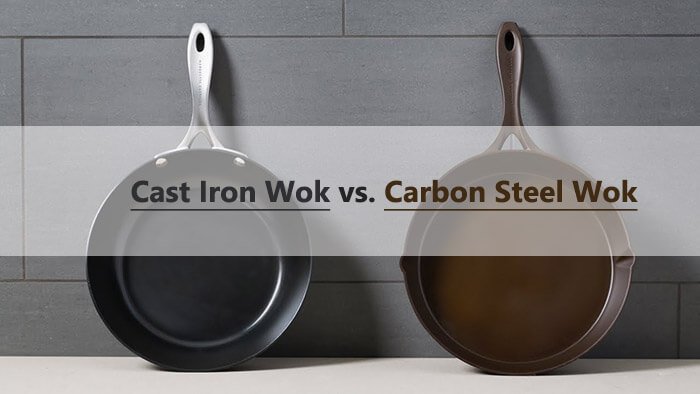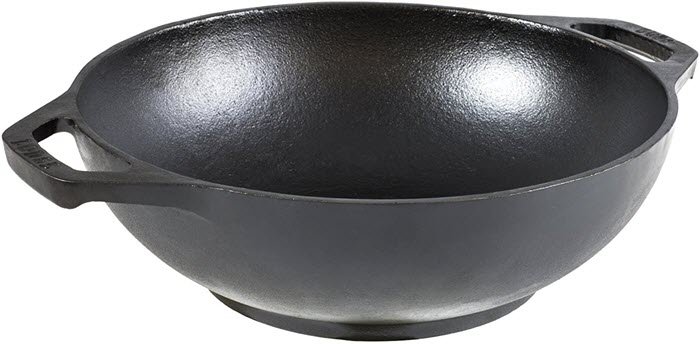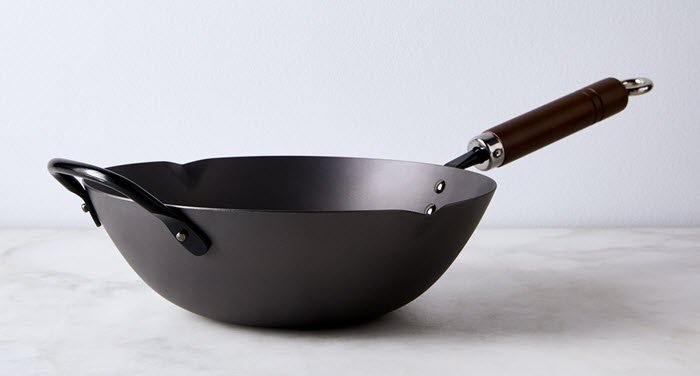Cast iron and carbon steel are both durable, high-quality materials that make for excellent cookware.
However, it’s crucial to consider their differences when choosing between a cast iron wok and a carbon steel option.
Notably, cast iron tends to be far heavier and more challenging to work with than carbon steel. That said, cast iron is tough enough for almost any cooking environment, indoor or outdoor.
So let’s explore both options to discover how they differ.
Table Of Contents
Cast Iron Wok Overview
A cast iron wok is a durable, thick piece of cookware appropriate for stovetops, ovens, and open campfires.
That’s because it’s made of solid cast iron, a material that conducts heat quickly and evenly and has an astounding melting point of about 2000℉.
Unlike other types of metals, cast iron is prone to rust if not adequately protected. For this reason, many cast iron woks are pre-seasoned (or polymerized) using a combination of oils and fats.
This coating helps repel water and prevent the iron from rusting away.
It’s also worth noting that cast iron is far heavier than stainless steel or hammered copper. This can make it challenging to work with, especially when attempting maneuvers involving the wrists and hands.
Reasons to Use Cast Iron Woks
- It is one of the most durable cookware materials in the world
- You can use a cast iron wok over almost any kind of heating source, including fire
- Heats quickly and evenly, ensuring that all ingredients cook at the same rate
Reasons Not to Use Cast Iron Woks
- Incredibly heavy, making it challenging to toss ingredients
- Requires special cleaning tools like chainmail scrubbing pads
- It can quickly begin to rust if not kept seasoned and relatively dry
Carbon Steel Wok Overview
Carbon steel is an iron-rich material that’s prized for its durability. It’s also great at conducting heat, making it a natural choice for cookware.
Additionally, carbon steel woks are often far thinner than cast-iron ones, and they tend to heat up more quickly.
Woks made of carbon steel are often lightweight, making them ideal for stir-frys and technique-focused meals. But just like cast iron, this material can be tricky to maintain and clean.
Reasons to Use Carbon Steel Woks
- They are super lightweight, making them easy to maneuver and manipulate
- Naturally non-stick when seasoned
- Heats extremely quickly and evenly
Reasons Not to Use Carbon Steel Woks
- Just as with cast iron, carbon steel can rust if improperly seasoned, washed, or dried
- Can warp with heat or if dropped onto a hard surface
Cast Iron Wok vs. Carbon Steel: How Are They Different?
When choosing between a cast iron and carbon steel wok, comparing their different capabilities and features is crucial. In doing so, you’ll likely discover which option best suits your needs.
For example, if you’re searching for a durable wok that’s appropriate for both home and backyard cooking, a cast-iron option may be your best bet.
However, if you’re looking for a lightweight option that allows you to practice your tossing techniques, a cast iron wok could be the right choice.
Still, no matter your ideal wok usage, there are a handful of factors to consider and compare, including:
- Durability
- Cleaning and Maintenance
- Weight
- Price
Let’s see how cast iron and carbon steel compare in these essential categories and discover which one might be right for you.
1. Durability
Cast iron is one of the most durable cookware materials. That’s why it’s not uncommon to find cast iron pans passed down through several generations. When properly seasoned and maintained, a cast iron wok could last you a lifetime or more.
Carbon steel, on the other hand, isn’t quite as durable. Not only is it less resistant to high temperatures, but it tends to warp when exposed to extreme heat. A carbon steel wok can also get bent out of shape if dropped onto the floor or accidentally slammed against a cabinet.
As such, cast iron is the more durable option. However, it’s not the easiest material to keep clean and rust-free.
2. Cleaning and Maintenance
Nearly all types of metal are prone to rust, but iron is particularly notorious for rusting. As such, cast iron wok owners will need to take special care when cleaning their cookware.
Standard dish soaps can strip away a cast iron wok’s protective coating, opening it to oxidation. When this happens, the surface of the wok can begin to form rust. Though you can scrub this rust away and re-season your wok, it requires plenty of time and elbow grease.
Still, carbon steel isn’t a rust-free option. Though you don’t necessarily need to keep your carbon steel wok seasoned, it’s often recommended. That’s because water and oxygen can cause this material to rust. A layer of cooking oil is usually enough to prevent this.
Overall, both materials are similarly finicky and prone to rusting.
3. Weight
There’s a reason why cast iron is one of the most popular materials for camping cookware: It’s tough enough to endure bumps, drops, and campfire flames. However, most cast iron pots and pans used during camping are noticeably tiny.
That’s because cast iron’s durability comes at a cost. While this material can withstand rough conditions, it’s also relatively heavy. This can make it challenging to work with, especially if attempting to toss or stir-fry ingredients.
Carbon steel, on the other hand, is far more prone to warping. This is because it’s typically not thick enough to endure fireside temperatures. That said, it’s far lighter. This makes carbon steel woks far easier to handle than cast iron ones.
4. Price
The final thing to consider is price.
After all, you may be prepared to invest in an exceptional-quality wok that can last for decades. Alternatively, you could be searching for a durable, budget-friendly option instead.
Generally, both cast iron and carbon steel woks are similarly priced. That said, you may be able to find more affordable carbon steel options than cast iron ones.
That’s because carbon steel is often far thinner than cast iron, necessitating less material to create each wok.
Generally, you can expect to spend between $20 and $100 for a carbon steel wok and approximately $40 and $120 for a cast iron wok.
FAQs About Cast Iron and Carbon Steel
Which wok is better cast iron or carbon steel?
It all depends. If you plan to cook oily foods only, a carbon steel wok will be a good choice since it heats up quickly due to its non-stick surface.
On the other hand, if you want to cook pan-fried noodles or stir-fried dishes, then a cast iron wok is your best choice since it will heat everything more evenly.
Is carbon steel wok toxic?
Carbon steel wok is safe to use. It’s made from iron and carbon which are natural materials without added toxic and harmful coatings.
How to season a new wok?
Please follow the guide shown in the following video to season a new wok.
Final Thoughts
When purchasing a new wok, it’s crucial to consider material. Both cast iron and carbon steel are excellent options, as they both conduct heat evenly and quickly. However, they do feature some notable differences.
Cast iron is heavy and can be challenging to work with. You’ll also need to invest in special cleaning tools if you choose cast iron. On the other hand, carbon steel is just as durable—and it’s lightweight!
This is all about carbon steel wok vs cast iron, feel free to let me know if you have questions.



